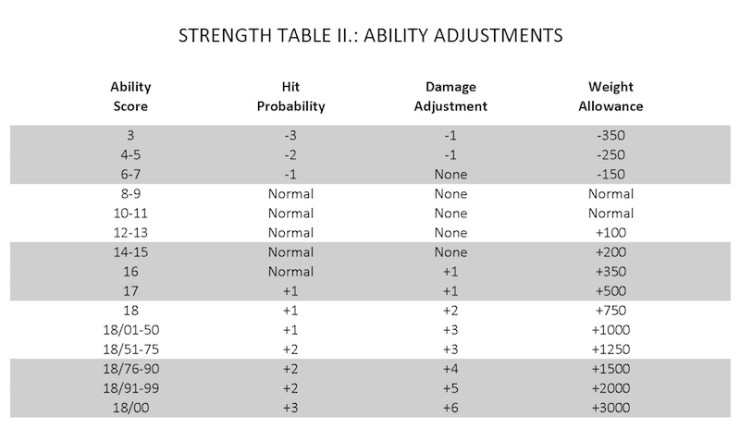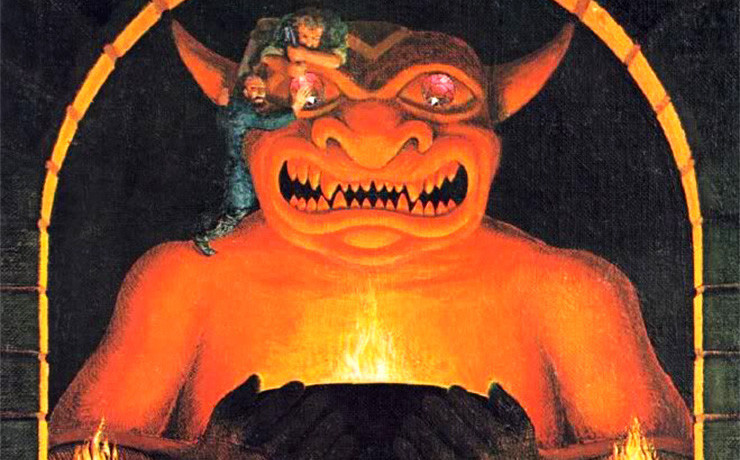Last week, after a book launch event at a used bookstore downtown, I became the proud owner of 1979 printings of the Player’s Handbook (PHB), Dungeon Master’s Guide, and Monster Manual from the first edition of Advanced Dungeons and Dragons (by Gary Gygax, as the covers proudly state).
So there I was, browsing the PHB and marveling at what the late 1970s considered optimal tabletop game design (racial preference tables! alignment-specific languages that you forget if you change alignment! different scaling for distances depending on whether you are above or below ground!), when I discovered that, uniquely among all the character attributes, the STR (strength) score has a numerical “in real life” quantification attached.
What would be my personal strength rating in Dungeons & Dragons?
Here’s what the PHB says about strength levels in reality versus fantasy:
For purposes of relating this ability to some reality, assume that a character with a strength of 3 is able to lift a maximum of 30 pounds weight above his or her head in a military press, while a character with 18 strength will be able to press 180 pounds in the same manner.
Perfect, I thought. Thanks to the power of the bodybuilding/powerlifting Internet, I can actually submit this casual assertion, obviously chosen because it scales from 30 to 180, to some empirical scrutiny. For the purposes of the rest of this post, I will be using Symmetric Strength as a basis for my estimates, and assuming a standing military press, aka standing overhead press, as the basis for the STR scale.
My first thought was, well, now I know my strength score! Last night at the gym, I did 5 sets of 5 reps of overhead press at 52.5 lbs, which by the Symmetric Strength estimate puts me at around a 61 lb one-rep max, being the maximum amount I could manage to get up in the air within press form parameters. Therefore, I have a STR score of 6.
My second thought was, okay, but how much would a fighter-class human expect to have as a real-world strength score? This turns out to be a little difficult to judge, since the clean and press hasn’t been an Olympic sport since 1972, in a time with less strict drug testing, although I can tell you that the world record at that time was Vasily Alekseyev with 521 pounds, being at a height of 6′1″ and a weight of, evidently, 350 pounds.
So how would this translate into AD&D terms? Given the linearity of Gygax’s scale, it is not inconceivable that this would translate into a strength score of 52, which is, I assure you, ludicrous. Alternatively, we can use the strength table Gygax provides, which conveniently informs us how the strength score affects one’s weight allowance:

Note, first, that for some godforsaken reason, the weight allowance is listed in gold pieces rather than pounds, with 10 GP weighing 1 lb. Note, second, that although the military press standard scales linearly, the weight allowance does not. Note, third, that as is the case in both editions of AD&D, if you roll an 18 on STR, you roll an additional D100 to find out just how 18 you are in strength as a fighter (a.k.a. the bane of people randomly rolling up a fighter-mage in Baldur’s Gate). Despite the non-linearity of the scale, I will assume that an 18/00 is in fact four times as strong as a regular 18. Assuming (this may be a large assumption) that a clean and press gives you a 1-rep max for the military press, then Alekseyev pressed 521/180 = 2.89 times a regular 18, which is equivalent to approximately a 2171 GP weight allowance, giving him a STR stat of approximately 18/93.
Sadly, women’s Olympic weightlifting wasn’t introduced until 2000, after the clean and press was no longer an event due to judging difficulties, so no real world record information exists for individuals lacking high-ish levels of testosterone.
My third thought was, okay, so how tall can we expect fighters to minimally be, given that in AD&D you need STR 16 to receive the customary XP bonus, and 17 to become “the character with two classes,” this being the original term for dual-classed characters? That’s where the Symmetric Strength website comes in, since it estimates 1-rep maxes by weight and gender (disclaimer: male/female are the only two categories, but it is my separate understanding from elsewhere that this is specifically a question of whether or not your muscle growth is helped by testosterone). I will say that I entered Alekseyev’s weight into the calculator and it estimated a world-class, i.e. internationally competitive, 1-rep max to be a mere (“mere”) 337 pounds, or approximately 18/70, but fortunately we can afford to split hairs on this matter because of the 18/?? system.
Now, the thing you have to know about weightlifting competition classes is that, although they are technically weight classes, at the highest levels they are actually height classes, because someone of my height (just short of 5′4″) can only put on so much muscle relative to someone who is 5′8″. Fortunately, the Symmetric Strength website has an estimation calculator for how much I would weigh if I were going to be maximally strong given my height, which turns out to be around 150 pounds and around 25% body fat. Entering this poundage into the estimator for a world-class 1-rep max, I get 167 lbs, or around a 17 STR. Using a similar calculation, a 6′ tall woman could in theory press 204 pounds while weighing around 223 pounds, giving a STR score of about 18/01.
Thus, I conclude that in fact, Gygax’s strength scoring system is actually…pretty good! But only good for fighters, in a system like AD&D where we can reasonably assume that all fighter PCs have been training for 10+ years and are genetically super-gifted. However, if you’re Raistlin Majere from the Dragonlance Chronicles and are in all probability an underweight untrained or novice lifter of average height, then you are probably looking at a STR score of around 6-7. If you are a woman of my current weight and untrained, you are looking at a STR score of around 3-4. If you’re my current weight and train consistently for a couple of years, you can expect to have a score of around 8-9. Men and/or individuals with higher testosterone levels will have somewhat higher scores, but it is definitely out of the question that a 10-11 can represent an average strength in our society, though it may be in a farmer-dominant society where everyone lifts a lot of hay bales.
This concludes my investigation, and I hope you enjoy the fruits of 90 minutes of my time.
This article originally appeared on Tumblr.
Top image from the cover to first edition Advanced Dungeons & Dragons Players Handbook. Art by David A. Trampier.
Bella Wang is a Ph.D. candidate in international relations and a long-time player of RPGs. She was supposed to be working on her dissertation, but instead spent half her afternoon researching the important tabletop questions of our day.










